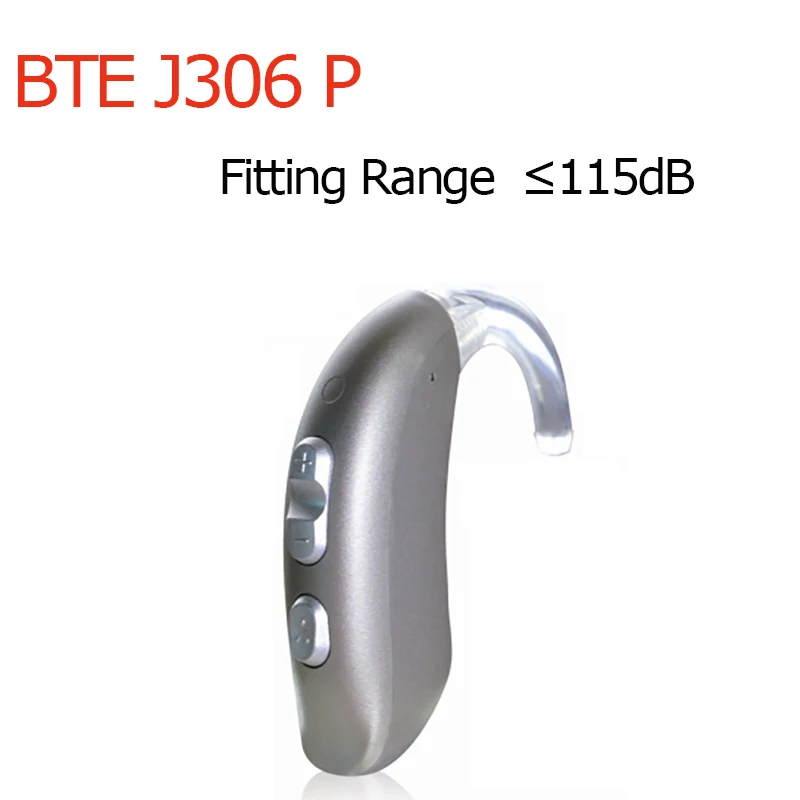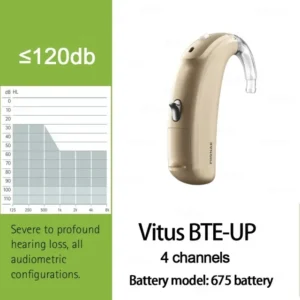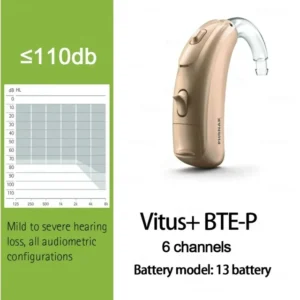
How Behind The Ear Hearing Aid Can Improve Your Hearing and Quality of Life
Hearing loss can have a significant impact on your daily life, affecting your ability to communicate, enjoy social activities, and even perform well at work. Fortunately, hearing aids can help improve your hearing and quality of life. One type of hearing aid that has been particularly effective for many people is the Behind-the-Ear (BTE) hearing aid. In this blog, we’ll explore how Behind The Ear Hearing Aid can improve your hearing and quality of life.
BTE hearing aids are a type of hearing aid that sits behind the ear and is connected to an earpiece that goes inside the ear canal. They are one of the most common types of hearing aids and for good reason. Behind The Ear Hearing Aids are versatile and can be used to treat a wide range of hearing losses, from mild to severe. They are also durable and often have longer battery life than other types of hearing aids.
One of the biggest benefits of Behind The Ear Hearing Aids is that they offer excellent sound quality. The technology used in BTE hearing aids allows for precise tuning, which means you can enjoy clear and natural sound. This is particularly important for speech recognition, as you will be able to hear and understand conversations more easily.
Behind The Ear Hearing Aids are designed to be comfortable to wear, even for extended periods of time. The earpiece that goes inside the ear canal is custom-made to fit your ear, which means it will fit snugly and securely. The device itself is lightweight, and the behind-the-ear component is discreet, so you won’t have to worry about it being visible.
Behind The Ear Hearing Aids are also easy to control. Many models come with a remote control or smartphone app, allowing you to adjust the volume or settings with ease. This is particularly useful in situations where you need to make quick adjustments, such as when transitioning from a quiet environment to a noisy one.
Another benefit of Behind The Ear Hearing Aids is that they are customizable. Your hearing healthcare professional can adjust the settings to match your individual hearing needs. They can also customize the earpiece to fit your ear canal, ensuring maximum comfort and effectiveness.
While BTE hearing aids offer many benefits, there are a few disadvantages to keep in mind. These include:
Behind The Ear Hearing Aids are made up of two main parts: the device itself and the earpiece. The device sits behind the ear and contains the microphone, amplifier, and battery. The earpiece is connected to the device and goes inside the ear canal.
When sound enters the microphone, it is converted into an electrical signal and sent to the amplifier. The amplifier increases the strength of the signal and sends it to the earpiece. The earpiece then converts the electrical signal back into sound waves and sends them into the ear canal, where they are processed by the ear and sent to the brain.
There are several different types of BTE hearing aids, each with its own unique features and benefits. Some of the most common types include:
When choosing Behind The Ear Hearing Aid, there are several factors to consider. These include:

A mini BTE (Behind-the-Ear) hearing aid is a smaller and more discreet version of the traditional BTE hearing aid. Here are some key characteristics and benefits of mini BTE hearing aids:
1. **Design:** Mini BTE hearing aids are designed to be less visible and more cosmetically appealing compared to standard BTE models. They typically have a smaller casing that sits behind or on top of the ear.
2. **Comfort:** Due to their smaller size and lightweight design, mini BTE hearing aids are often more comfortable to wear, making them suitable for extended use throughout the day.
3. **Sound Quality:** Despite their compact size, mini BTE hearing aids can provide excellent sound quality and amplification for individuals with mild to moderate hearing loss. They may incorporate advanced digital signal processing technology for improved speech clarity and noise reduction.
4. **Earmold Options:** Mini BTE hearing aids can be paired with various earmold styles, including custom-made molds that fit comfortably in the ear canal. This customization helps optimize comfort and sound delivery.
5. **Features:** Many mini BTE hearing aids offer a range of features such as directional microphones, telecoil technology for better phone compatibility, wireless connectivity (Bluetooth), and rechargeable battery options.
6. **Versatility:** Mini BTE hearing aids are suitable for a wide range of hearing needs and can accommodate different levels of hearing loss, from mild to moderately severe.
7. **Maintenance:** Like other types of hearing aids, regular cleaning and maintenance are important to ensure optimal performance and longevity of mini BTE devices.
Overall, mini BTE hearing aids combine advanced technology with a compact and discreet design, providing users with enhanced comfort and improved hearing capabilities. They are a popular choice for individuals seeking a balance between performance and aesthetics in their hearing solution.
“BTE hearing aids with Bluetooth” refers to Behind-the-Ear hearing aids that are equipped with Bluetooth technology. This allows them to wirelessly connect to Bluetooth-enabled devices such as smartphones, tablets, and TVs.
The integration of Bluetooth technology in BTE hearing aids offers several advantages:
Overall, Bluetooth-enabled BTE hearing aids provide greater convenience, flexibility, and improved connectivity options for individuals with hearing loss.
A BTE (Behind-the-Ear) hearing aid with an earmold is a common configuration used to deliver amplified sound to individuals with hearing loss. Here’s how this setup typically works:
1. **Behind-the-Ear (BTE) Component:** The main part of the hearing aid sits behind or on top of the ear. It houses the electronics, microphone, and amplifier.
2. **Earmold:** The earmold is a custom-made piece that fits snugly into the ear canal. It is connected to the BTE hearing aid via a thin tube or wire. The earmold is custom-made to ensure a comfortable and secure fit for the wearer.
3. **Functionality:** Sound is captured by the microphone in the BTE unit, processed, and amplified. The amplified sound is then delivered through the tube to the earmold, where it is directed into the ear canal. This setup allows for precise adjustment of amplification levels to meet the individual’s hearing needs.
4. **Customization:** Earmolds are tailored to each individual’s ear anatomy for optimal comfort and effectiveness. They are typically made from silicone or acrylic materials and can be designed in various styles (such as full shell or half shell) depending on the degree of hearing loss and personal preferences.
5. **Maintenance:** Regular cleaning and maintenance of both the BTE unit and the earmold are essential to ensure optimal performance and hygiene.
BTE hearing aids with earmolds are versatile and suitable for a wide range of hearing loss types, from mild to profound. They provide robust amplification and can accommodate additional features such as telecoil for better compatibility with hearing loops in public venues. Audiologists play a crucial role in fitting and adjusting BTE hearing aids with earmolds to ensure they provide the best possible hearing improvement for the wearer.
BTE (Behind-the-Ear) hearing aids utilize thin tubes to deliver sound from the main hearing aid unit, which rests behind or on top of the ear, into the ear canal. These tubes are a crucial part of the device and serve several important functions:
1. **Sound Transmission:** The primary role of the tube is to carry amplified sound from the hearing aid unit to the ear canal, where it can be heard by the user.
2. **Flexibility:** Hearing aid tubes are designed to be flexible and lightweight, ensuring comfort and ease of use for the wearer.
3. **Customization:** Tubes come in various lengths and sizes to accommodate different ear shapes and hearing needs. Audiologists can select the appropriate tube length and configuration during the fitting process to optimize sound delivery and comfort.
4. **Retention and Stability:** The tube helps secure the hearing aid behind the ear and keeps it in place during daily activities.
5. **Maintenance:** Tubes are typically detachable, allowing for easy cleaning and replacement when necessary. Regular maintenance ensures optimal performance and longevity of the hearing aid.
Overall, the design and material of Behind The Ear Hearing Aid tubes play a crucial role in the effectiveness and comfort of the device for individuals with varying degrees of hearing loss.
“BTE hearing amplifier” typically refers to a type of device that is similar to a hearing aid but is generally simpler and more affordable. These devices are designed to amplify sound for individuals who may have mild to moderate hearing loss but do not necessarily require the sophistication or customization of a traditional hearing aid.
Key features of BTE hearing amplifiers include:
It’s important to note that while BTE hearing amplifiers can provide benefit to some users, they do not address all types of hearing loss or offer the same level of customization and performance as hearing aids prescribed and fitted by audiologists.
Using BTE (Behind-the-Ear) hearing aids alongside glasses is a common concern for many individuals. Here are some considerations and tips for wearing BTE hearing aids with glasses:
1. **Fit and Comfort:** When wearing both BTE hearing aids and glasses, it’s essential to ensure that both devices fit comfortably together on your ears. Some people may find that adjusting the placement of either device slightly can improve comfort.
2. **Frame Style:** The style of your glasses frame can impact how well they work with BTE hearing aids. Frames with thinner arms or temples can sometimes provide more space behind the ear, reducing interference with the hearing aid.
3. **Ear Molds and Glasses:** If you use custom ear molds with your BTE hearing aids, ensure that they are fitted correctly and comfortably. Sometimes, adjustments may be needed to accommodate both the ear mold and the glasses frame.
4. **Consultation with Professionals:** If you’re experiencing discomfort or issues with fit, consult with your audiologist or hearing healthcare professional. They can make adjustments to the hearing aids or provide guidance on how to wear them comfortably alongside your glasses.
5. **Consider Alternatives:** In some cases, alternative hearing aid styles such as In-the-Ear (ITE) or Receiver-in-Canal (RIC) hearing aids may be more suitable if wearing glasses with BTE devices proves consistently uncomfortable or impractical.
Ultimately, with proper fitting and adjustment, many people successfully wear BTE hearing aids and glasses simultaneously. Communication with your audiologist and experimentation with different strategies can help find the best solution for your individual needs.
When looking for reviews of BTE (Behind-the-Ear) hearing aids, there are several sources you can consider to gather information about different models, brands, and user experiences. Here are some places where you can find BTE hearing aid reviews:
1. **Manufacturer Websites:** Many hearing aid manufacturers provide detailed information and customer reviews on their websites. This can be a good starting point to learn about specific models, features, and customer satisfaction.
2. **Independent Review Websites:** There are websites and forums dedicated to reviewing and discussing hearing aids. Sites like Hearing Tracker, Healthy Hearing, and Hearing Aid Forum can provide comprehensive reviews from users and experts alike.
3. **Professional Audiologists:** Consulting with a licensed audiologist or hearing healthcare provider can offer valuable insights based on their experience with fitting and recommending Behind The Ear Hearing Aids to patients.
4. **Consumer Reports:** Occasionally, consumer advocacy organizations like Consumer Reports may publish reviews and ratings of hearing aids, including BTE models, based on independent testing and user feedback.
5. **Social Media and Online Communities:** Platforms like Facebook groups, Reddit threads (such as r/hearing aids), and other online communities can be a source of peer-to-peer reviews and discussions about Behind The Ear Hearing Aids.
When reading reviews, consider the following factors:
– **Performance and Sound Quality:** Look for feedback on how well the hearing aids perform in various listening environments, including noisy settings and quiet conversations.
– **Comfort and Fit:** Reviews often discuss how comfortable the Behind The Ear Hearing Aids are to wear, especially when combined with glasses or other accessories.
– **Battery Life and Maintenance:** Information on battery life (whether disposable or rechargeable) and ease of maintenance (cleaning, changing filters, etc.) can be crucial.
– **Features and Connectivity:** Reviews may cover special features like Bluetooth connectivity, telecoil options, smartphone apps for control, and compatibility with other devices.
By consulting multiple sources and considering various perspectives, you can make a more informed decision about which BTE hearing aid might best suit your needs or the needs of someone you care about.

Behind The Ear Hearing Aids are an excellent option for anyone who is experiencing hearing loss. They offer excellent sound quality, are comfortable to wear, and can be customized to match your individual needs. While they do have a few disadvantages, the benefits outweigh the drawbacks for many people. When choosing Behind The Ear Hearing Aid, be sure to talk to your hearing healthcare professional about your options and what you can expect. With the right support, you can improve your hearing and quality of life.
How to Manage Tinnitus at Home: If tinnitus is mostly noticed in quiet situations, first you should try using a white noise machine to mask the noise. If you don’t have a white noise machine, a fan, soft music or low-volumed static radio will help.




How do you deal with tinnitus? If tinnitus is mostly noticeable in quiet situations, try using a white noise machine to mask the noise from tinnitus. If you don’t have a white noise machine, a fan, soft music or low-volume radio static also may help.